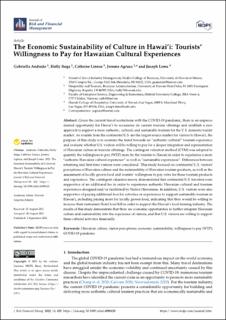| dc.contributor.author | Andrade, Gabriella | |
| dc.contributor.author | Itoga, Holly | |
| dc.contributor.author | Linnes, Cathrine | |
| dc.contributor.author | Agrusa, Jerome | |
| dc.contributor.author | Lema, Joseph | |
| dc.date.accessioned | 2021-10-14T12:19:02Z | |
| dc.date.available | 2021-10-14T12:19:02Z | |
| dc.date.created | 2021-09-04T09:10:46Z | |
| dc.date.issued | 2021 | |
| dc.identifier.citation | Journal of Risk and Financial Management. 2021, 14 (9), Artikkel 420. | en_US |
| dc.identifier.issn | 1911-8066 | |
| dc.identifier.uri | https://hdl.handle.net/11250/2823051 | |
| dc.description.abstract | Given the current travel restrictions with the COVID-19 pandemic, there is an unprecedented opportunity for Hawai’i to reexamine its current tourism offerings and establish a new approach to support a more authentic, cultural, and sustainable tourism for the U.S. domestic tourist market. As tourists from the continental U.S. are the largest source market for visitors to Hawai’i, the purpose of this study is to examine the trend towards an “authentic cultural” tourism experience and evaluate whether U.S. visitors will be willing to pay for a deeper integration and representation of Hawaiian culture in tourism offerings. The contingent valuation method (CVM) was adopted to quantify the willingness to pay (WTP) more by the tourists to Hawaii in order to experience a more “authentic Hawaiian cultural experience” as well as “sustainable experiences”. Differences between returning and first-time visitors were considered. This study focused on continental U.S. visitors’ perceptions of Hawaiian culture and the sustainability of Hawaiian tourism products, as well as the assessment of locally grown food and tourists’ willingness to pay extra for these tourism products and experiences. The contingent valuation survey demonstrated that continental U.S. travelers were supportive of an additional fee in order to experience authentic Hawaiian cultural and tourism experiences designed and/or facilitated by Native Hawaiians. In addition, U.S. visitors were also supportive of paying additional fees for activities or experiences to support sustainable tourism in Hawai’i, including paying more for locally grown food, indicating that they would be willing to increase their restaurant/hotel food bill in order to support the Hawaii’s local farming industry. The results of this study demonstrate that there are economic opportunities to further integrate Hawaiian culture and sustainability into the experience of visitors, and that U.S. visitors are willing to support these cultural activities financially. | en_US |
| dc.language.iso | eng | en_US |
| dc.publisher | MDPI | en_US |
| dc.rights | Navngivelse 4.0 Internasjonal | * |
| dc.rights.uri | http://creativecommons.org/licenses/by/4.0/deed.no | * |
| dc.subject | Hawaiian culture | en_US |
| dc.subject | visitor perceptions | en_US |
| dc.subject | economic sustainability | en_US |
| dc.subject | willingness to pay | en_US |
| dc.subject | WTP | en_US |
| dc.subject | COVID-19 pandemic | en_US |
| dc.title | The Economic Sustainability of Culture in Hawai’i: Tourists’ Willingness to Pay for Hawaiian Cultural Experiences | en_US |
| dc.type | Peer reviewed | en_US |
| dc.type | Journal article | en_US |
| dc.description.version | publishedVersion | en_US |
| dc.rights.holder | © 2021 by the authors. | en_US |
| dc.subject.nsi | VDP::Samfunnsvitenskap: 200::Økonomi: 210 | en_US |
| dc.source.volume | 14 | en_US |
| dc.source.journal | Journal of Risk and Financial Management | en_US |
| dc.source.issue | 9 | en_US |
| dc.identifier.doi | 10.3390/jrfm14090420 | |
| dc.identifier.cristin | 1931321 | |
| dc.source.articlenumber | 420 | en_US |
| cristin.ispublished | true | |
| cristin.fulltext | original | |
| cristin.qualitycode | 1 | |

